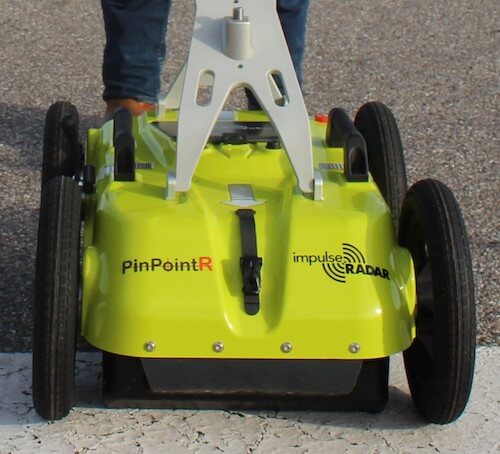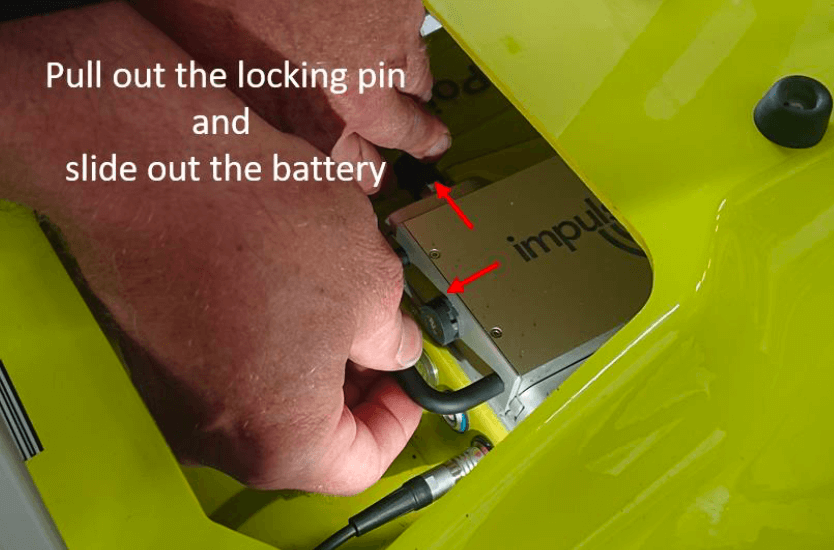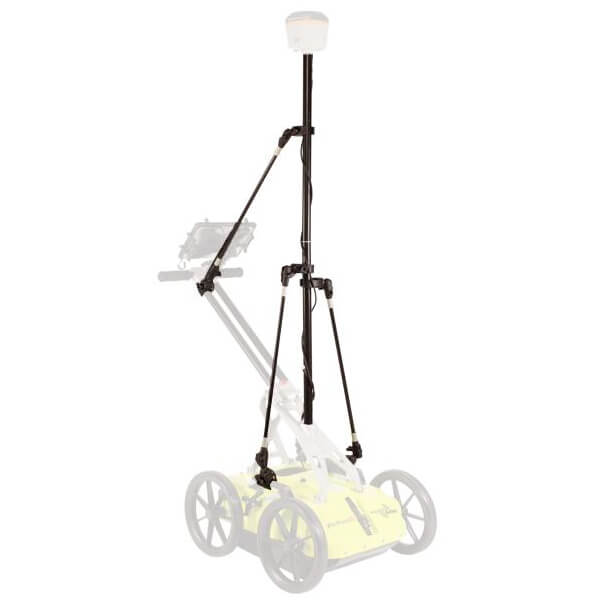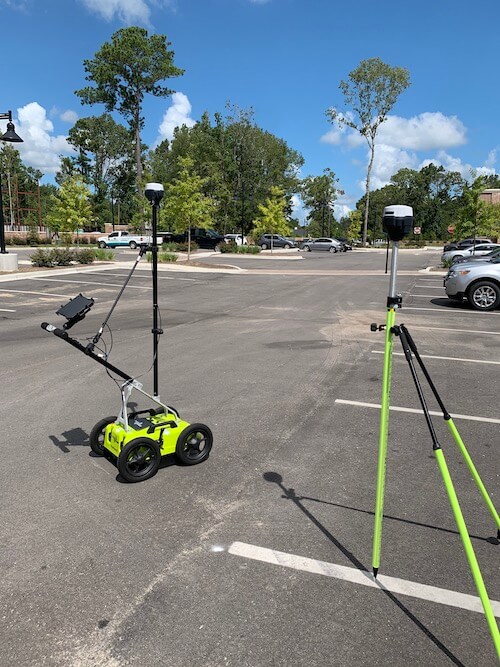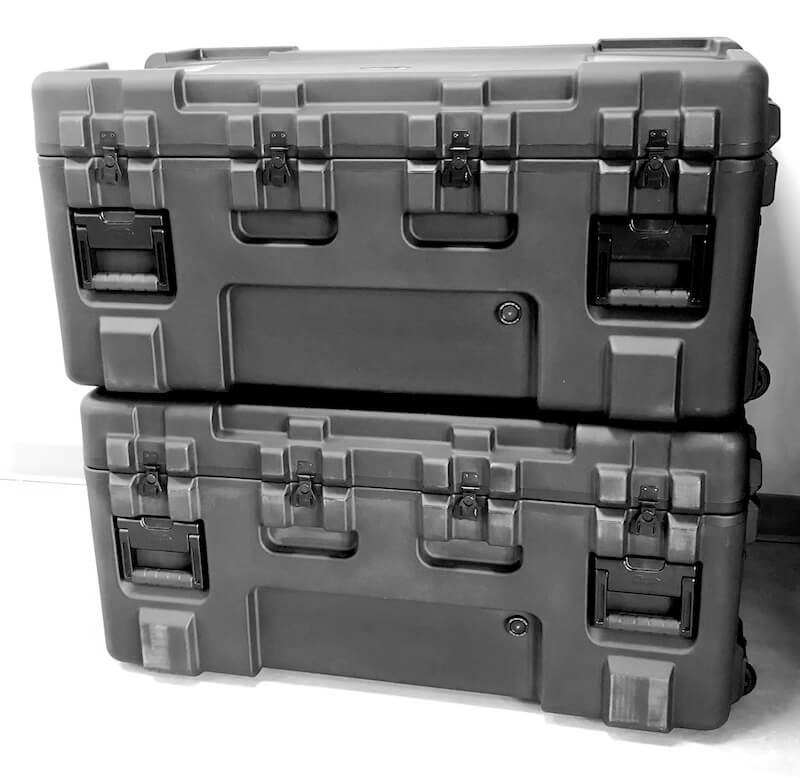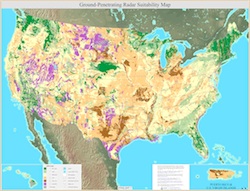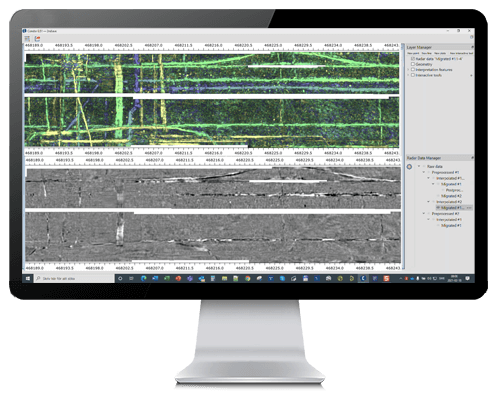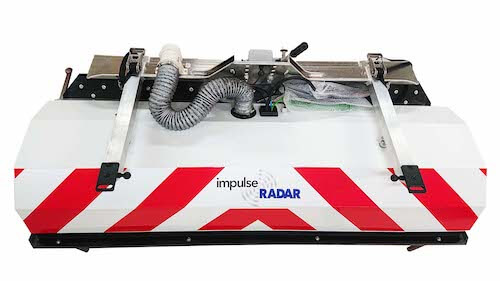- Compact design
- Dual Channel Antenna
- Wireless data acquisition
- How does GPR work?
- (RTS) Real-time Sampling
- Li-Ion Battery
- ViewPoint OS
- Ruggedized Tablet
- Tablet Case
- Screen Shots
- Warranty
Light-Weight Compact & Robust Design
The PinPointR's light weight design (only 44 lbs.) and its foldable frame is perfect for utility locators who do multiple locates a day and need to continuously transport, store and set-up at different Job sites. This design makes transporting much easier and can be stored in smaller vehicles, giving owners more choices for vehicles. In addition to the use of premium materials is its composite antenna weather-cover enclosure. This composite enclosure provides another level of protection, making the PinPointR the industry leader for robust design.
Internal GPS, with external GPS support (NMEA 0183 protocol).
Key Features:
- Composite Antenna Housing - WEATHER PROTECTION
- Integrated Odometer - BUILT-IN
- Large Wheels - STANDARD
- Folding Handle - EASY TO STORE
- Lifting Handles - EASY TO LIFT
- Brake - SECURE CART ON INCLINE
- Skid Plate - REPLACEABLE
- Ratchet Straps - QUICKLY ADJUSTS ANTENNA

True Dual Channel Radar Antenna Technology
Dual channel radar from Impulse Radar uses dual frequencies, i.e., 400MHz (LF) & 800MHz (HF), providing enhanced bandwidth and resolution that is way beyond any single channel GPR's capabilities. Along with its RTS-based wireless antenna technology, and its high performance, and no survey speed limitations, this allows users the best opportunity to locate deeper and near surface targets even in tough soil conditions, without the need to worry about how fast to push the cart.
Article: Single channel UWB vs Multi channel GPR
Key Features:
- 400MHz & 800MHz- DUAL FREQUENCIES
- Li-Ion Battery - INTEGRATED DESIGN
- GPS - INTERNAL GPS RECEIVER
- GNSS/RTK - CONNECTOR FOR EXTERNAL
- RTS Platform - REAL-TIME SAMPLING

Wireless Data Acquisition Technology
No cables to be lost or broken which simplifies set-up and in-field productivity and reduces service cost. Utilizing wireless design improves its overall cost of ownership.
However for the owner the best news of all maybe the use of having the latest Samsung tablet as your "digital video recorder" or head unit. Using a proven Samsung device via an Android app, I.e., ViewPoint provides users with a very proven and affordable and friendly design.
Impulse Radar continues to improve and add features and all these features are available to you via its normal Android App updates.
Using the latest Samsung tablet guarantees the latest display and processing technology and should something ever go wrong, or lost, or stolen, is very affordable to replace. Whereas competitive systems dependent on in-house built display units are only as new as the year at which they were designed and extremely difficult to keep updated and very expensive to replace.
The PinPointR wireless design solution is easily a win-win situation for any cart owner.
Key Features:
- Wireless - NO CABLES TO FAIL
- Tablet Display - UTILIZE LATEST LCD
- Android - OS RUNS ON TABLET

How does GPR work?
GPR works by transmitting a small pulse of ultra-wide band (UWB) electromagnetic energy into the earth where one is searching for targets and then records the time it takes for some of that energy to be returned, to the receiver along with a measure of its signal strength. A GPR antenna, which contains both transmitting and receiving element, is placed on, or very near the surface of the earth and moved across the area to scan. By continuously transmitting pulses and recording the associated returns, a radiogram image of the subsurface can be generated and viewed in real-time on a suitable screen (tablet). Changes in the earths composition of the subsurface can be seen based on air, mineral and water content, presence of bedrock or other geological features and objects such as buried utility lines.
Key Features:
- No need to hook-up - BUILT-IN TRANSCEIVER
- Locates non-metallic - LOCATE PLASTIC, CONCRETE PIPE
- Confirm Locates - GPR CAN CONFIRM EM
- Sweep for utilities - GPR IS A PERFECT METHOD FOR SWEEPING
- UnLocatables - GPR CAN LOCATE DIFFICULT UTILITIES
- Plastic Pipe w/No tracer wire - GPR CAN LOCATE THE PLASTIC PIPE

Signal sampling methods
All GPR systems need to sample analog signals from the antenna and digitize them for processing and display. The sampling method, as well as the rate at which samples are taken, can significantly affect the quality of results. Therefore, the sampling rate is an important specification that determines system performance.
Traditionally, GPR systems have utilized a technique called equivalent time-sampling, which requires a new pulse to be sent from the transmitting antenna for every sample recorded on the receiver end. We refer to systems using this method as "conventional GPR".
RTS - Real-time sampling
Modern designs and new components now make it possible to use a technique called real-time sampling (RTS). RTS is the method that Impulse Radar uses in all its designs. As there name implies, it means that the "real" signal is captured directly and in sharp contrast to conventional systems, it does not require repetition of transmission-recording cycle, The rest is a GPR system that gathers data thousands (1,000x) of times faster than a conventional GPR system.
Key Features:
- Real-Time Sampling (RTS) dramatically reduces background noise levels, making it possible to see underground targets that other systems cannot see.
- This is accomplished by collecting tens of thousands more data stacks in the same or less time frame.
- There are no longer speed limitations on how fast you push or pull the antenna across the ground. Older systems have limitations and require much slower data collection. Some older systems even display a color oriented indicator to let users know they need to slow down.
- Having no speed limitations make the PinPointR a much safer system to operate in busy intersections.


RTS Technology provides thousands of stacks of data which dramatically reduces the background noise levels providing greater depth of penetration. This can be achieved without sacrificing speed of data collection, unlike some other competitive systems. E.g., the Raptor array setup can achieve these results at speeds of up to 80 MPH. Therefore the PinPointR push cart has no limitations, thus requiring no need to monitor how fast one should collect data. Other systems utilizing similar stacking techniques require very slow walking speeds and may even need to employ a means of monitoring the speed at which you push the cart to slow the user down if necessary.

Simplicity
An RTS system does not require the control unit that is central to the configuration of conventional GPR systems. Consequently, there are less cables and inter-module communications, making the RTS system more practical and field friendly. Not having a dedicated control/display unit is much less to go wrong and much less costly to replace.
Penetration depth/sensitivity
Since an RTS system collects data much faster, the collection rate is used to lower the system noise floor, which effectively increases the signal penetration depth. To our knowledge a true 16-bit data has never been gathered with conventional GPR systems, whereas an TRS based system may easily exceed 20-bit.
Survey speed
While conventional systems can rarely be used at speeds higher than 50 km/h (w/o increasing the point distance), an RTS system may be used at virtually any speed. This equates to quicker surveys and more importantly for searching for utilities on busy intersections, users can quickly scan an area as fast as needed to avoid oncoming traffic, making the PinPointR a much safer GPR cart for utility locating technicians.
Li-Ion Battery
The PinPointR is standard with a high capacity rechargeable Li-Ion battery pack. This battery is designed to last up to 7-hours continuous operation.
Key Features:
- Li-Ion Battery - RECHARGEABLE
- Integrated design - NO CABLE OR BOX
- Extreme Life - 7-HOURS
- Long Service Life - LASTS 1,000 CYCLES


ViewPoint
ViewPoint from ImpulseRadar is an Android data acquisition application (App) that controls the PinPointR antenna and features. The Viewpoint App enables wireless connectivity between the tablet and the PinPointR antenna.
ViewPoint is a modern intuitive user interface to maximize your in-field productivity with features and functionality designed around daily workflows.
Key Features:
- View Maps simultaneously next to data in real-time
- Single or multi-line collection
- Mapping with Google Earth Support - generate KMZ files
- Geo-referencing with Google Map Integration - Use built-in GPS or external GNSS RTK for centimeter level accuracies
- Collects Data according to your needs
- Efficient Utility Marking - APWA uniform color code
- Multi or Single channel selection (400MHz or 800MHz or both)
- Depth & Soil Velocity via hyperbole match
- Apply gain at various depths or entire line
- Pinch to zoom in or out - Intuitive
- Marker Assignment and precise placement
- Save Data and Map Screenshots
- Gain and Contrast
- Automatic Field Report Generation
- Email on-site reports (PDF) to customers

Ruggedized Tablet Display
PinPointR uses an android based acquisition application, which allows for an Android-based user interface (IPR App). Data acquisition and control via tablet or smartphone. WiFi - wireless data collection and data logging via internal MiniSD card - back-up/data protection. When paired with the Samsung Tab Active Pro Ruggedized tablet, users get excellent high definition display along with the latest Android OS (Pie). Meets MIL Spec. STD-81DG and is IP68 rated.
Key Features:
- Galaxy Tab Active Pro 10.1 - SAMSUNG
- 720 X 1280 Pixel or better - SCREEN RESOLUTION
- Version 9 Pie or newer - ANDROID OS
- 2.7 GB SDRAM or better - MEMORY
- Intel Atom x5-Z8550, Quad-core 2.3 GHz Krait 400 or better - PROCESSOR
- Meets MIL Spec. STD-81DG - RUGGEDIZED
- IP68 - WEATHER AND DUST RESISTANT
Other GPR carts using in-house builds for display units typically become obsolete before they even go one or two years into production. They are often sourced with older LCD screens and obsolete OS throughout their life cycle. These OEM display units also cost at least 5x or more to replace should one ever get damaged or lost.
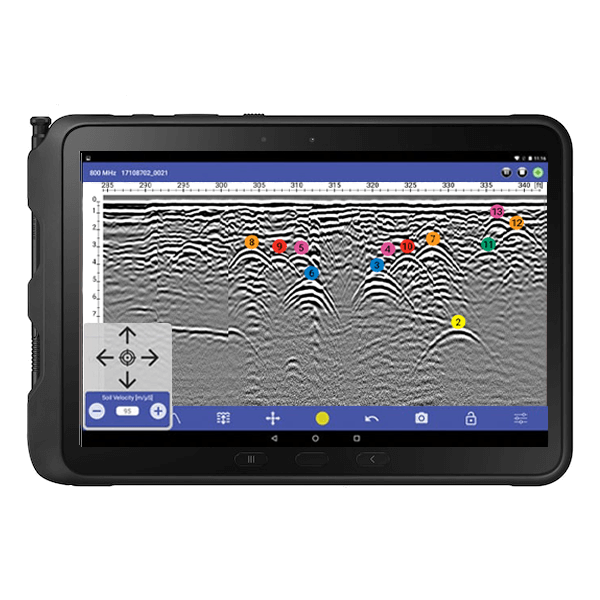
Ruggedized Case
Protect your Tablet with a Pelican ruggedized case.

Using 400MHz
The Real-time sampling provides superior data, even in tough scenarios. Shown are targets at different depths. Notice the antenna using RTS technology has excellent resolution on both shallow and deep targets.

Markers
The Marker button allows users to mark pipe targets with the corresponding APWA Color marker.

Mapping
The Mapping feature of ViewPoint app provides automatic mapping when cart is used. Below using the internal GPS.

Mapping w/RTK GNSS
The Mapping feature of ViewPoint app using the optional EMLID RTK GNSS receiver (>1cm).
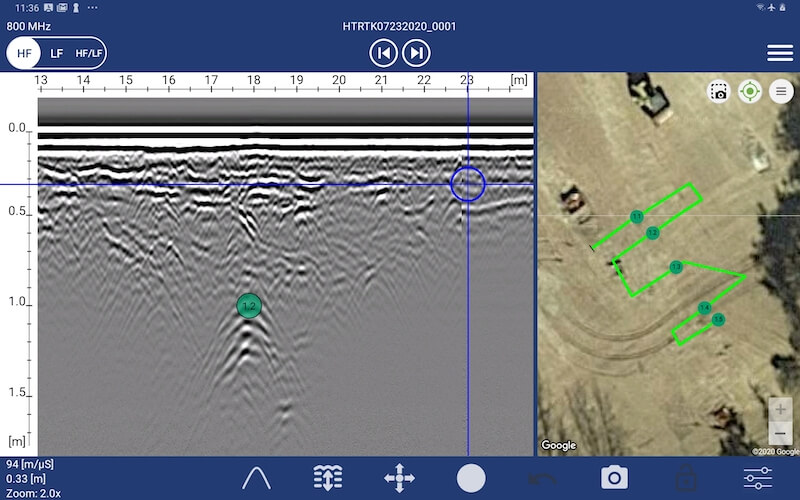
Using 800MHz with RTS
The high frequency (800MHz) is perfect for detecting shallow targets. Shown is a power cable ~2 ft. below concrete slab.

Soil Velocity Adjusting
Adjusting for different soil types is easy, fast and accurate. Adjusting the velocity using the hyperbola matching ensures accurate depths.

Warranty
Impulse Radar provides a 2-year warranty on the antenna and cart.
ImpulseRadar is so confident in the quality and performance of the PinPointR GPR technology that they offer an industry leading 2-Year Warranty.
- Tracer Electronics LLC is an authorized warranty repair center for ImpulseRadar - LOCAL SERVICEABILITY
- Many competitors only offer 1-year warranty.
- Some competitors require "Out-of-country" repair centers.





